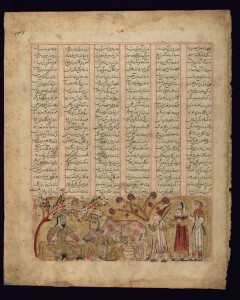Book-hoarding, 10th Century Style
Anyone who's spent a significant amount of time with me in recent months, whether in real life or in some virtual space, has probably heard me bemoan the state of my office bookshelves. As the photo above attests, they overflow. Loaded two deep and stacked rather than shelved, there is still not enough room. Worse, for the first time in my life I am having trouble finding things. Twice in the last year I bought a book I already owned. Once because I couldn't find the copy I was sure I had and needed right then. Once because I didn't even realize I owned a copy.* It makes me itchy.
Recently, a factoid has begun popping up in my universe that makes me feel even worse. According to Alberto Manguel, author of A History of Reading,
In the tenth century… the Grand Vizier of Persia, Abdul Kassem Ismael, in order not to part with his collection of 117,000 volumes when traveling, had them carried by a caravan of four hundred camels trained to walk in alphabetical order.
Manguel goes on to explain that the camel drivers effectively served as librarians, each responsible for retrieving volumes from his camel at the vizier's command.
At first, I found the factoid charming: a lovely illustration of the importance of books in the early Islamic world. Then I felt a little jealous at the idea of owning 1117,000 books. Now I just feel inadequate at my inability to keep control over a couple of thousand books without the added complication of moving camels.
Something's gonna change.
*Oh, the shame!
The Art of the Book
The Islamic world created illuminated manuscripts that rivaled anything that came out of a medieval monastery: Qu'rans, historical chronicles, stories of the prophets, the deeds of kings, lyric poetry, heroic epics, philosophy, scientific treatises, and romantic tales.
Caliphs, courtiers, and wealthy merchants commissioned manuscripts from the ninth century until well into the seventeenth century, when the Islamic world reluctantly accepted the value of Mr. Gutenberg's printing press. Each manuscript was an expensive and unique production that required the talents of many artists: craftsman who ruled the pages, calligraphers, painters, illuminators, bookbinders and chest makers.
Each page was designed with a ruled frame that determined the number of lines of text on the page and the size and location of paintings, chapter headings, texts and borders. The modern viewer focuses on the miniatures, wonderfully detailed paintings often no larger than a sheet of notebook paper. For the original audience, the paintings are second to the quality of the calligraphy. As sixteenth Iranian author Qadi Ahmad put it, "If someone, whether he can read or not, sees good writing, he likes to enjoy the sight of it." Calligraphers were not anonymous copyists, but revered artists who learned at the hand of a master.
Unlike books in English, where there are many fonts but only one script, Islamic calligraphers had many scripts to chose from, each with a different graphic and emotional quality. They could be slanted or rounded, upright or "hanging", angular or cursive. Some were designed to be easily read, others to be decorative. Qu'rans were often written in one of the angular kufic scripts. One script was described as the "bride of calligraphic styles" and was generally used for lyric poetry and romantic tales.
You've got to wonder what the producers of these works would think about the modern paperback.
This post previously appeared at Wonders and Marvels.
Road Trip Through History: America’s First Interstate
George Washington was a road builder long before he was a nation-builder. As a young officer under the ill-fated General Braddock, he helped construct a military road from western Maryland to Pennsylvania.* As president of the new United States, he dreamed of a trans-Appalachian road that would unify the new nation and aid westward expansion.
In 1806 Thomas Jefferson signed a bill that made Washington's dream a reality.** Funded by the sale of land in what would become Ohio, the National Road was built in pieces between 1811 and 1834. It was carved out of wilderness and prairie, constructed of rock and dirt and mud and macadam over timber corduroys. When it was completed, the National Road traveled through six states, from Cumberland, Maryland, to Vandalia, Illinois, then the state capital.
The National Road became a major route not only for settlers traveling west, but for commerce. Conestoga wagons, the semi-trailers of the early nineteenth century, carried farm produce from the west to eastern cities and brought back supplies and luxuries to frontier towns. Drovers herded pigs from Vandalia to Baltimore along the road. (And turkeys as far as Saint Louis.***) As the frontier developed, the National Road became Main Street in the towns through which it traveled.
The road flourished through the 1870s, when the railroad replaced it as a major transport system. It revived at the beginning of the twentieth century, when the rise of the automobile brought with it a demand for better roads. The National Road was reincarnated as Highway 40 and expanded from Vandalia to the Pacific.
The National Road Interpretive Center in Vandalia is an excellent introduction to the history of the road--not to mention surveying methods, covered bridges, frontier road construction, the economics of wagon trains, and the development of the Illinois territory. But be warned, it will leave you wanting more. My Own True Love and I are already plotting a road trip through history along the Illinois portion of the National Road. Stay tuned.
*And helped trigger the French and Indian War in the process. But that's a story for another day.
**Jefferson's own dream-- a road that went all the way to the Pacific--took a little longer to fulfill.
***Does anyone know how you herd turkeys? I assume you walk softly and carry a big stick.







